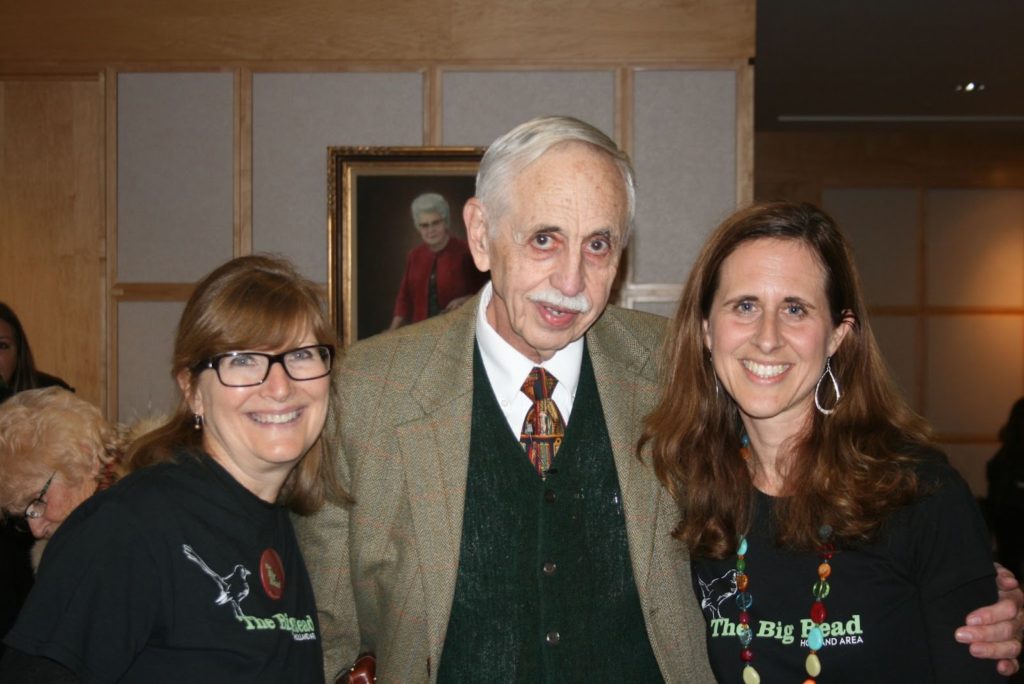By Deb Van Duinen
As we continue to celebrate the 10-year anniversary of The Big Read Lakeshore, we want to highlight some stories from the past couple of years from a few of the many people who helped form The Big Read into what it is today. Our first memories come from Professor Deborah Van Duinen, who began the program in Holland and nurtured it into what it is today. As we launch our newest books, she reflects on the journey of starting The Big Read in our community.
It started ten years ago with a conversation between friends.
During one of the fall months in 2013, I remember asking Joel Schoon-Tanis, a friend and local artist, about his latest art projects. In the following conversation, he told me about an upcoming project in Wisconsin. There, he would do another collaborative art project with high school students involved in a community-wide reading program. He had done this in previous years and absolutely loved creating art with students after reading a piece of literature. This year, the students he would be working with were reading Our Town by Thorton Wilder.
“The community over there gets a grant called “The Big Read” from the National Endowment for the Arts.” I remember him telling me. “You should check it out. It’d be fun to do something like that here in Holland.”
Full disclosure: I had never written a grant proposal before and knew little about community-wide reading programs or the National Endowment for the Arts. However, I knew Joel well enough to know that if he thought something would be a good idea, it probably was.
Full disclosure again: I was a new, pre-tenured faculty member at Hope College. I wanted to get tenure and promotion and knew that grants, publications, and service commitments were the currency to achieve this.
Long story short, in January 2014, I applied for an NEA Big Read grant: my first NEA grant, my first grant.
I had no idea what I was getting myself into.
I quickly learned that applying for a national grant is no small task. For one, many grant requirements need to be followed. These include everything from budget details and publicity materials to evaluation processes and confirmed community partnerships.
For this particular grant, I learned that I needed to choose a book from a list of Big Read selected titles. Not knowing what kinds of books work best for a community-wide reading program, I went with a book that I loved, Harper Lee’s To Kill a Mockingbird. As a former high school English teacher, this was one of my favorite books to teach, and it was (and continues to be) one of my all-time favorite books to read. This was the easy part. The rest of it? Not so much.
While submitting the grant in 2014, I also learned that most grant writers aren’t successful the first time around. In fact, many grant writers use a failed first attempt to learn what to do better the next time. This makes it all the more difficult to establish community partnerships and support. With no promise of an actual program or effective results, I remain so grateful for the librarians at Herrick District Library, the local English teachers, and the directors of nonprofit organizations like the Holland Museum who were willing to partner with me from the beginning.
In April 2014, I received an email from the NEA informing me that my grant proposal had been accepted.
And the rest, as we say it, is history.
The first year of programming was magical. We hosted seven events and 16 book discussions. Over 300 people participated in our program. Our main speakers included Mary Marshall Tucker, a neighbor of Harper Lee, and Dr. Wayne Flynt, an Alabamian historian, and friend of Harper Lee. Dr. Fred Johnson delivered our kickoff address, and we screened a documentary, Our Mockingbird, followed by a Skype talk with the director, Sandra Jaffee. Joel Schoon Tanis collaborated with students in five schools to create beautiful pieces of art and also designed a community art piece made up of hundreds of mockingbirds that answered the question: “Who are our mockingbirds?”
Conversations about the book and its topics and themes were rich and meaningful. Community members of all ages listened to and learned from each other. We made new connections with each other. We discovered new insights together.
The overwhelming success of this first year propelled us to apply for another grant in 2015 and then again in 2016 and 2017 and so on. And now, here we are in 2023 embarking on our 10th programming year.
Stay tuned for future blog posts that highlight memories from each of our previous years but for now, here’s to another year of showcasing a diverse range of themes, voices, and perspectives. Here’s to another year of coming together, as a community, around the shared activity of reading and discussing the same book. Here’s to inspiring meaningful conversations, artistic responses and new discoveries and connections along the Lakeshore.



